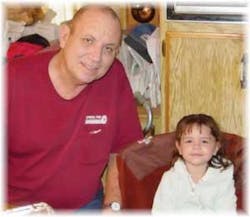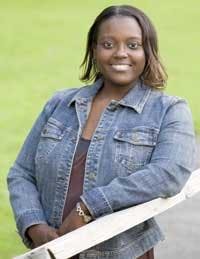Smoking Cessation
Seeing the Light Through the Smoked-Filled Room
As I shopped late at night on December 21 of last year, I looked around at all the happy people picking out Christmas gifts. Such a fun time for them ...
I confess to you that tears streamed down my face as I watched the cheerful people. I envied them. I was also there to shop, but for a different reason. My father was dying and I was chosen by the family to buy his clothes for his funeral. Although he hadn’t passed away yet, it would be soon. My heart ached.
Every time I looked at a button-down shirt, all I could imagine was what it would look like on my father lying in his casket. As I heard people behind me asking, “Why is that lady crying?” and the Christmas tune “It’s the most wonderful time of the year” in the background, I found irony in the moment. I have to admit it was one of the hardest things I have ever done in my life.
I found a perfect shirt in a blue and green plaid, a pair of navy slacks, a belt, undershirt and even socks. I was so thankful the department store stayed open late for the holidays. I don’t think I could have shopped during the day with the crowds.
My heart still breaks when I think of that night. It felt like a dream. After I came home, I washed the clothes and stayed up until 2 a.m. meticulously ironing and packing them in a box to be sent overnight by courier to the nursing home where hospice was caring for my father. I also sent photos of my daughter so he would have one more chance to see her. But the box didn’t make it on time, and he never had the chance to see her again in life or photos. My heart still breaks over that. My father called my then two-year-old daughter “Twinkle Toes” because she loved to sing “Winkle, Winkle, Little Star” to him. He was very proud of her, and very much wanted to see her grow up.
My father died on Dec. 22 at 6:10 p.m. My box that was supposed to arrive by 10 a.m. that day was stuck on a plane in a snowstorm in Cincinnati.
I’m sure you’re wondering why I’m telling you all this. First of all, every minute of your life counts. Second, take good care of your health. Third, if my father hadn’t smoked cigarettes, he would still be here today to see his only granddaughter grow up.
Did you know that smoking is the most preventable cause of death in America? I feel such guilt because I should have been more persistent with my father to quit. But I had this mental block that lung cancer only happens to other people and other families. Wrong! What kind of dental professional am I if I can’t even encourage better health for my own family and friends? Why didn’t I encourage my father more often to quit smoking? I guess I thought it didn’t matter. My father loved his cigarettes.
Did you know that of the 46 million people who smoke, 70 percent say they want to quit? With just a little help, motivation, and encouragement from family and friends, the chances are very good they can quit smoking. It may be too late for my father, but it’s not for you, my fellow dental professional.
Did you know that one in every five deaths is attributed to smoking? I sure didn’t. Lung cancer is the number one cancer killer in America, claiming more lives than breast, prostate, and colorectal cancers combined. But research money is not available to put it on the forefront. In 2001, approximately $1,200 per lung cancer death was spent as compared with $11,425 per breast cancer death, $8,190 per prostate cancer death, and $3,350 per colorectal cancer death. Why? Many people consider lung cancer self-inflicted. Plus, consider the loss in revenue for tobacco companies if people stop smoking.
My father smoked for 50 years. He started when he was 11. Almost 90 percent of adult smokers began at or before age 18. Smoking contributed significantly to my father’s disposition to have lung cancer, specifically small cell cancer, which is extensive and spreads rapidly. My father was diagnosed in October 2004, and he was gone before Christmas of the same year. It was a big reality check for me, and even more so for him.
Here are a few lung cancer facts:
• Lung cancer is the leading cancer killer
• 28 percent of cancer deaths are from lung cancer
• Early detection is critical to survival, yet most are diagnosed in late stages
• 87 percent of lung cancers are smoking related
• 80 percent of lung cancers are diagnosed in the advanced stages where chemotherapy and radiation therapy may slow the progress but not cure it
There are two main types of lung cancer. Non-small cell makes up 80 percent of all cases, and small cell makes up the other 20 percent. Small cell is directly related to smoking. Non-small cell cancer is divided into three classifications: adenocarcinomas (affecting the lining of the mucus glands, also the most common type), squamous or epidermoid carcinoma (bronchial tubes), and large cell carcinoma. These cancers can be detected early, thus increasing the victim’s survival chances.
Exposure to other carcinogens such as secondhand cigarette smoke, asbestos, and radon gas can increase a person’s risk for lung cancer. One needn’t be a smoker to be diagnosed with it. It is interesting to note that most nonsmokers diagnosed with lung cancer are women, and it is often due to secondhand smoke.
After talking with several of my father’s friends and co-workers, I believe he had signs and symptoms of lung cancer long before he was diagnosed. He had persistent chest, shoulder, and back pain unrelated to pain from coughing. Other symptoms were a cough that lasted longer than two weeks, and constant wheezing upon exertion. Unfortunately, symptoms of lung cancer may take years to appear. They are often confused with the symptoms of less serious health conditions, and they may not appear until the disease is advanced, as in my father’s case. Depending on which organs are affected, these symptoms can include headaches, general weakness, pain, bone fractures, bleeding, or blood clots. Anyone experiencing these symptoms should consult a physician immediately. My father’s cancer metastasized to his pelvis bone, shoulder, and stomach. It wasn’t until he was in extreme pain that he finally visited a physician.
His cancer could have been detected by a chest X-ray or a CT, a PET scan or an MRI, which are newer, more sensitive imaging scans that reveal more details than other tests, if he had gone to the doctor earlier.
Treatment options for lung cancer include surgery to remove the tumors, chemotherapy and radiation therapy, and new cancer drugs. But I won’t ever know what might have worked, because my father brushed aside the pain and lived with it until it was too late, thinking it was just part of “getting old.”
Morphine was his best friend at the end. His pain was agonizing. I saw him less than a week before he passed, as I live 2,000 miles away. The last time I saw him his legs were swollen, he was going into heart failure because fluid was not circulating in his body, and his organs were slowing down. The doctor had given him three to six months to live, so I thought I had more time.
Thank goodness for hospice, a program for people to die with dignity. He did die with dignity, just sooner than I thought he would. My three-month window turned into less than two weeks.
The special package with his clothes and photos finally arrived the day before the funeral. He looked like what I imagined he would, peaceful in his plaid shirt and navy slacks. He was never fussy about his clothing. The shirt, despite being lost in cold weather for a few days, still displayed the ironing creases I had so ceremoniously placed. I was in disbelief and I think I still am. It’s just not fair.
I gave my father’s eulogy, and I told everyone about telling my daughter that her Grandpa was sick. As she leaned over to kiss my father’s forehead, she said, “It’s all better now, Grandpa Bill.” I wish it were that simple to take cancer away.
Now I’m mad ... at myself. I wish I had been more proactive about smoking cessation because he might still be here. That’s why I’m writing this article. If I can reach one person - you - and encourage you to start your family and friends on a smoking cessation program, I am on my way to my goal. I might not have saved my father, but maybe I can help save someone else’s life.
So for those reading this article who smoke or know someone who does, give it up! Now! Not tomorrow, not later. Life is too short and precious to waste the valuable time that can be spent with your family and friends. While taking actions can greatly decrease a person’s chances for developing lung cancer, be aware that there is no way to prevent the disease entirely. But smoking cessation is essential for prevention of lung cancer. Spread the word.
There are many resources on smoking cessation, including our own hygiene association, the American Dental Hygienists’ Association (www.adha.org). Another organization for information about lung disease is the American Cancer Society (www.cancer.org). Other Web sites include:
• www.lungcancer.org
• www.cancercare.org
• www.surgeongeneral.gov/tobacco
I will always cherish the memories of my father, and I hope I have personalized the disease of lung cancer. I encourage you to become more familiar with smoking cessation programs and to share that knowledge. You are a dental health professional. Sharing knowledge could save a life. Smoking is a deadly, addictive habit. Break the habit, help someone else break the habit, and improve his or her quality of life. I wish I had done that for my father.
Trish Jones, RDH, BS, is a technical advisor for Aurum Ceramic Dental Laboratories and serves as a company representative at various dental conventions. She has an associate’s degree in dental hygiene and a bachelor’s degree in health-care management from Southern Illinois University.
About the Cover
Raushanah Shareef-Jefferson, RDH, practices in Grand Prairie, Texas, where she recently relocated from Washington, D.C. A graduate of Howard University School of Dentistry, she received several scholarships and honors, including a Howard University Trusteee Scholarship, a New Era Dental Hygiene Scholarship, a Colgate-Palmolive/National Dental Association Foundation Scholarship Award, and the National Society of Collegiate Scholars. But she lists among her proudest accomplishments the birth of her second child, Michael, while in the middle of her first year of school in February 2001. “Three weeks after giving birth, I returned to complete the rigorous schedule ... There were many nights where I would have my son in one arm and a book in the other. I learned not to look at financial hardships, having children, and/or other responsibilities as a roadblock to my success, but an obstacle that I needed to overcome.” Raushanah has been married for seven years and is also the mother of a nine-year-old daughter, Bria.


